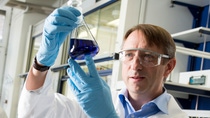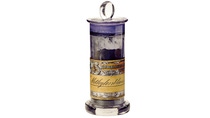Agriculture
The Colour Of Hope
BASF scientist, Matthias Witschel, is seeking new ways to combat malaria. A 19th century dyestuff is playing an important role.

BASF scientist Matthias Witschel has been working for several years to show how crop protection know-how can support the fight against neglected tropical diseases.
Weeds – that’s the usual focus of Matthias Witschel’s work. As one of BASF’s Principal Scientists, he develops herbicides to help farmers combat these troublesome visitors to their fields. Nothing to do with tropical diseases like malaria you might say. “Actually there is a connection between the two areas that has interested me from very early on” commented Witschel, who has a Ph.D. in chemistry. “The parasites that cause malaria and leishmaniasis are more similar to plants and fungi than to bacteria.” This is because both the malaria pathogen Plasmodium and plant or fungus cells are all ‘eukaryotes’, or cells with a single nucleus. This is what makes them different to bacteria. In addition, Plasmodium has an internal, plant-derived legacy; it has an organelle (a tiny cellular organ), originally based on an algae cell, that has been incorporated during the evolution of the malaria parasite.

This is why herbicide researchers like Matthias Witschel can contribute to the fight against malaria: for example, substances that block the production of proteins and amino acids in weeds, can theoretically do the same thing in Plasmodium parasites. This approach was the focus of a six-month sabbatical that the chemist took in 2009 with the ETH (Swiss Federal Institute of Technology) in Zurich. Together with Professor François Diederich, he investigated crop protection compounds to see if they could be used to help treat malaria - and vice-versa. Because the knowledge from malaria research is also valuable for the development of new herbicides.
The collaboration that started then is still ongoing today and has already lead to over a dozen scientific publications. As a first step in the program, BASF provided the Swiss Institute for Tropical and Public Health (SwissTPH) with discontinued compounds from herbicide research. “One of these compounds is now being investigated intensively in a project funded by the Bill and Melinda Gates Foundation and could provide a potentially new mode of action against malaria” said Matthias Witschel. “But it will take many years before it can be used to treat people.”
But it has not taken so long for methylene blue, already a proven malaria medication (read about its unusual history below), to become an important contender in the fight against this tropical disease that kills almost half a million people every year. Plasmodium has now developed resistance to most of the known active substances used to treat malaria, so that doctors are welcoming new alternatives with open arms. Methylene blue is known to work well against the particularly deadly strain of the disease Malaria tropica and its parasite Plasmodium falciparum. Even more interesting is the potential use of this 19th century dyestuff as medication against Malaria tertiana caused by Plasmodium vivax. Significantly fewer people die from this strain of the disease than from Malaria tropica, but it is very difficult to clear the body of the parasite permanently. It lodges itself in the liver and causes the disease to break out repeatedly. “This doesn’t just strain the patient’s body but it also leads to immense economic damage”, explained Matthias Witschel, who has initiated further studies on methylene blue as part of this research program.
Like the other malaria parasites, Plasmodium vivax has a complex lifecycle that plays out partly in the human body and partly in the Anopheles mosquito. Its persistent recurrence is due to its ability to settle permanently in the human liver. Scientists like Professor Olaf Müller from Heidelberg University hope that methylene blue will be able to combat the parasite within the organ and prevent the regular cycle of relapses. Experts from German universities in Heidelberg and Munich and the University of Jimma in Ethiopia are currently studying methylene blue to see if this is what actually happens. “They have already had very promising results in the lab” commented Matthias Witschel. “It would be fantastic if it works out – as methylene blue, unlike the only current alternative, has no strong side effects." BASF is supporting this research project and also the dedication and commitment of Matthias Witschel, whose work on malaria research has been carried out predominantly in his free time.
From dyestuff to malaria medication
Methylene blue has had a fascinating career. Its history goes back to the 19th century, when it was the first synthetic dyestuff on the market and began to put pressure on its predecessors, plant-based dyes.
The German chemist, Heinrich Caro started working on this very current topic soon after he was named as BASF’s first head of research. In 1876, he discovered a new synthetic dyestuff for wool – methylene blue – and in 1877 it was the subject of BASF’s first patent for a coal tar dye.
By 1886, the later Nobel Prize winner, Paul Ehrlich, had already discovered that methylene blue is excellent for coloring the cells of the malaria pathogen Plasmodium. He speculated that perhaps the substance could also be used as malaria medication. Ehrlich was right. In 1891, he published a research study on two patients whom he had been able to cure with methylene blue. By that time though, quinine was already available as a malaria treatment and so methylene blue was slowly forgotten. Until that is a few years ago, when Professor Olaf Müller from Heidelberg University started more in-depth research on this proven active ingredient. Today methylene blue is viewed as a very promising weapon against Malaria tropica and Malaria tertiana.








